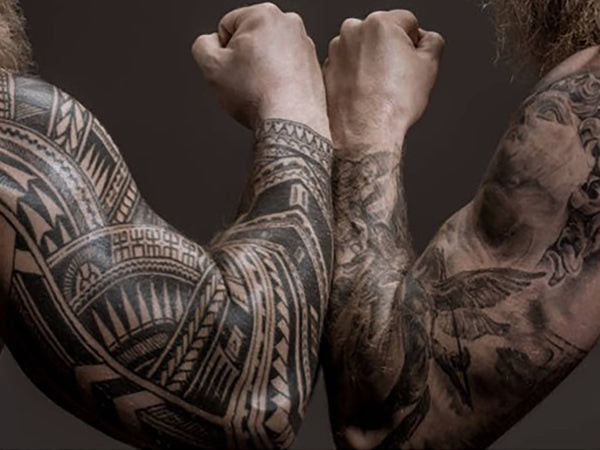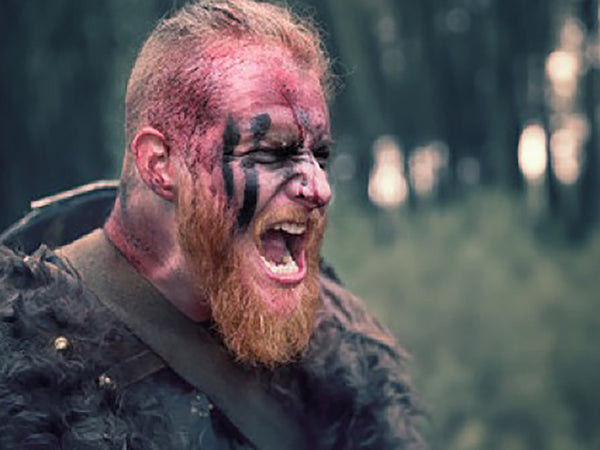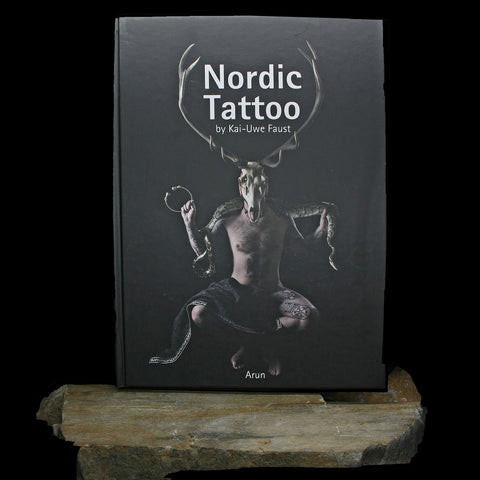Did Vikings get their tattoos? Yes, Vikings likely adorned their bodies with tattoos, a practice hinted at by historical accounts and archaeological findings, a captivating aspect of Norse culture explored further at tattooat.com. These ancient body modifications, if present, would have used natural pigments and hand-poked techniques. Delve into the world of Viking body art to uncover the captivating art forms of Norse warriors, exploring Norse mythology tattoos, Viking symbols, and historical accounts on tattooat.com.
1. What Historical Evidence Suggests Vikings Had Tattoos?
Vikings may indeed have sported tattoos, as evidenced by accounts from travelers who encountered them. The best evidence we have comes from Ahmad Ibn Fadlan, an Arab emissary, who described Vikings in Eastern Europe as being tattooed from “fingernails to neck” with dark blue images of trees and symbols. Similarly, Ibn Yaqub, a Sephardic Jewish merchant, noted the use of tattoos and makeup among Vikings in Denmark. While no Viking texts mention tattoos, these accounts provide strong evidence that Vikings practiced body modification.
Ibn Fadlan’s detailed observations remain a cornerstone in understanding Viking culture, even influencing modern interpretations of Viking aesthetics. His writings, carefully analyzed by historians, suggest a widespread and accepted practice of tattooing within Viking society.
2. What Were Viking Tattoo Designs Likely To Be?
Viking tattoo designs likely incorporated elements from their natural surroundings and belief systems. Ibn Fadlan’s description of “dark blue images of trees and symbols” points to the use of natural motifs and abstract representations. Given the Vikings’ deep connection to Norse mythology, runes, animals (such as wolves, ravens, and dragons), and other symbolic figures may have been common tattoo subjects. We know from other art forms that Vikings were also exceptionally skilled at creating intricate knotwork designs, and there’s no reason to believe they wouldn’t have used this on their skin too. These tattoos would have likely held personal, spiritual, or status-related meanings.
 Viking Sleeve Tattoo with Knotwork and Runes Alt text: Intricate Viking sleeve tattoo featuring knotwork patterns and runic symbols, showcasing Norse artistry and cultural heritage
Viking Sleeve Tattoo with Knotwork and Runes Alt text: Intricate Viking sleeve tattoo featuring knotwork patterns and runic symbols, showcasing Norse artistry and cultural heritage
The use of these symbols wasn’t merely decorative; they likely served as powerful identifiers, markers of status, or even spiritual conduits. Understanding the symbolism helps modern enthusiasts connect with the deeper meanings behind Viking-inspired tattoos, an avenue for exploration offered at tattooat.com.
3. How Did Vikings Create Their Tattoos?
Vikings likely used hand-tapping or hand-poking techniques to create their tattoos. These methods involve using a sharp object, such as a bone needle or sharpened stick, to puncture the skin and then rubbing pigment into the wound. Viking tattoo inks were likely made from natural materials like ash, charcoal, kohl, and plant fibers. These substances could have been mixed to create dark pigments, particularly in shades of blue, which was a color Vikings were known to produce from wood ash.
The creation process was likely a communal activity, with skilled individuals within the community acting as tattoo artists. This method connects modern tattooing practices with ancient traditions, reinforcing the historical roots of body art.
4. Did Vikings Use Any Form of Anesthesia For Tattooing?
Vikings might have used herbal remedies to alleviate pain during tattooing. Historical evidence suggests that Vikings possessed knowledge of medicinal plants and were capable of creating pain-relieving salves. These salves could have been applied topically to numb the skin before and after the tattooing process, reducing discomfort. The understanding of natural remedies highlights the resourcefulness and sophistication of Viking medicinal practices.
5. Besides Tattoos, What Other Forms of Body Art Did Vikings Practice?
Vikings also practiced body and face painting. Archaeological finds, such as animal hair brushes and sponges, suggest the use of cosmetics and paint for various purposes. Face paint was likely used in rituals, ceremonies, and perhaps even in battle. In Viking art, gods like Odin and Thor are often depicted with facial and body markings, suggesting that such practices held cultural and symbolic significance. These forms of body art offered Vikings a means of self-expression and cultural identity beyond permanent tattoos.
6. What Role Did Body Art Play in Viking Society?
Body art, including tattoos and paint, likely played a significant role in Viking society. It may have served as a means of personal expression, cultural identification, religious symbolism, and social status. Tattoos could have indicated tribal affiliation, achievements, or spiritual beliefs. Face and body paint may have been used in rituals, ceremonies, or as a form of intimidation in warfare. Body modification, in general, appears to have been a widespread and accepted practice in Viking culture.
 Viking Face Paint and Tattoos Alt text: A Viking warrior with striking face paint and intricate tattoos, embodying the fierce and artistic spirit of Norse culture
Viking Face Paint and Tattoos Alt text: A Viking warrior with striking face paint and intricate tattoos, embodying the fierce and artistic spirit of Norse culture
Exploring the role of body art provides insights into the values, beliefs, and social structures of Viking society. The visual language of these practices offers a unique window into their world, fostering a deeper appreciation for their cultural richness.
7. Were Viking Tattoos Only for Warriors?
Viking tattoos were likely not exclusive to warriors. While the idea of heavily tattooed Viking warriors is popular, historical accounts suggest that both men and women adorned their bodies with tattoos. Ibn Fadlan and Ibn Yaqub both noted that both sexes used tattoos and makeup. This suggests that body modification was a broader cultural practice, not limited to any particular social group or profession.
8. What Colors Were Used in Viking Tattoos?
Vikings primarily used dark blue or black pigments for their tattoos. While Ibn Fadlan mentioned seeing green tattoos, it is believed that dark blue was a more common color. Vikings were known to create an inky-blue dye from wood ash, which would have been readily available and easy to produce. Other natural materials like charcoal and kohl could have been used to create black pigments. The limited color palette reflects the available resources and technological capabilities of the time.
9. How Accurate Are Modern Viking Tattoos?
Modern Viking tattoos are inspired by historical accounts, archaeological finds, and Norse mythology. While they may not be 100% accurate representations of Viking tattoos, they capture the spirit and aesthetic of Norse culture. Common motifs in modern Viking tattoos include runes, knotwork, animals, weapons, and mythological figures. Artists often incorporate these elements into intricate and visually striking designs.
The authenticity of modern interpretations depends on the artist’s understanding and respect for historical sources. Tattooat.com can guide enthusiasts to artists who prioritize accuracy and cultural sensitivity in their Viking-inspired designs.
10. Where Can I Find Inspiration for Viking Tattoos?
Inspiration for Viking tattoos can be found in various sources, including historical texts, archaeological artifacts, Norse mythology, and modern interpretations of Viking art. Museums, books, and online resources can provide a wealth of information and visual references. Websites like tattooat.com offer galleries of Viking-inspired tattoo designs and connect users with talented artists specializing in this style.
11. What Are Some Common Viking Tattoo Symbols and Their Meanings?
Several Viking symbols are popular choices for tattoos, each carrying significant meaning:
- Runes: Ancient Norse alphabet with magical and divinatory properties. Each rune represents a specific sound and concept.
- Mjölnir (Thor’s Hammer): Symbol of protection, strength, and divine power.
- Vegvísir (Viking Compass): A symbol of guidance and protection, believed to help the wearer find their way through storms and rough seas.
- Ouroboros: A serpent eating its own tail, representing the cyclical nature of life, death, and rebirth.
- Trikvetra: Three interlocking horns symbolizing Odin, representing wisdom, inspiration, and poetic fury.
Understanding these symbols enriches the tattoo experience, allowing individuals to connect with the cultural and spiritual heritage of the Vikings.
12. What Was the Social Status of Tattooed Individuals in Viking Society?
The social status of tattooed individuals in Viking society is not explicitly documented. However, given the widespread use of tattoos and other forms of body art, it is likely that they were an accepted and perhaps even respected part of society. Tattoos may have indicated status, achievements, or affiliation with a particular group. While we cannot know for sure, it is reasonable to assume that tattoos played a role in shaping social identities and relationships in Viking culture.
13. Did Viking Women Have Tattoos?
Yes, Viking women likely had tattoos. Historical accounts, such as those by Ibn Fadlan and Ibn Yaqub, indicate that both men and women among the Vikings practiced tattooing. This suggests that tattoos were not limited to any specific gender or social role. The designs and meanings of women’s tattoos may have differed from those of men, but the practice of body modification appears to have been common among Viking women.
14. What Materials Did Vikings Use to Make Tattoo Ink?
Vikings used natural materials to make tattoo ink, including:
- Wood ash: Used to create a dark blue or black pigment.
- Charcoal: Produced a black pigment.
- Kohl: A dark powder made from antimony sulfide, used for creating black pigment and eye makeup.
- Plant fibers: Certain plants may have been used to create natural dyes for tattoo ink.
- Ochre: Earthy pigment with iron oxide that could produce shades of brown, red, or yellow.
These natural materials were readily available and allowed Vikings to create durable and visually striking tattoos.
15. How Long Did Viking Tattoos Last?
Viking tattoos likely lasted for a long time, possibly a lifetime. The hand-poked method of tattooing, combined with the use of natural pigments, would have created permanent or semi-permanent markings on the skin. While the colors may have faded over time, the tattoos would have remained visible for many years. The longevity of these tattoos underscores their significance as enduring symbols of identity and cultural belonging.
16. Did Vikings Have Tattoo Artists?
Vikings likely had individuals within their communities who specialized in tattooing. These tattoo artists would have possessed the skills and knowledge necessary to create intricate designs and apply them safely. They may have been respected members of society, entrusted with the task of creating meaningful and lasting body art. The existence of tattoo artists suggests that tattooing was a specialized craft in Viking culture.
17. What Is the Connection Between Viking Tattoos and Norse Mythology?
Viking tattoos were often closely connected to Norse mythology. Many common tattoo symbols, such as Mjölnir, Vegvísir, and various Norse gods and creatures, were derived from mythological stories and beliefs. These symbols served as visual representations of Viking spirituality, values, and worldview. By incorporating mythological elements into their tattoos, Vikings could express their faith, seek protection from the gods, and connect with their cultural heritage.
18. Did Vikings Use Tattoos as a Form of Identification?
Vikings may have used tattoos as a form of identification. Tattoos could have indicated tribal affiliation, family lineage, or personal achievements. In a society with limited forms of written communication, tattoos may have served as a visual means of identifying individuals and their place within the community. This use of tattoos as identification highlights their practical and social significance in Viking culture.
19. Were Tattoos Common Among All Vikings, or Only Certain Groups?
Tattoos appear to have been common among a wide range of Vikings, including both men and women. Historical accounts suggest that the practice of tattooing was widespread and accepted in Viking society. While certain groups or individuals may have had more elaborate or significant tattoos, it is likely that tattooing was a common practice among Vikings of various social classes and occupations.
20. How Did Viking Tattooing Practices Compare to Other Ancient Cultures?
Viking tattooing practices shared similarities with those of other ancient cultures. The use of hand-poked techniques and natural pigments was common among many indigenous societies around the world. However, Viking tattoo designs and symbolism were unique to their culture and belief system. The emphasis on Norse mythology, runes, and natural motifs distinguished Viking tattoos from those of other ancient cultures.
21. How do we know about Viking tattoos if they didn’t write about them?
We know about Viking tattoos primarily through the accounts of travelers who encountered them. The writings of Ahmad Ibn Fadlan and Ibn Yaqub provide valuable insights into Viking culture, including their use of tattoos. These accounts, combined with archaeological evidence and interpretations of Viking art, allow us to piece together a picture of Viking tattooing practices.
22. Are there any Viking tattoo designs that are considered offensive or disrespectful today?
Yes, certain Viking symbols may be considered offensive or disrespectful today if used without proper understanding or cultural sensitivity. For example, some runes have been appropriated by hate groups and should be avoided. It is important to research the meaning and history of any Viking symbol before using it in a tattoo. Consulting with cultural experts or tattoo artists specializing in Viking art can help ensure that your tattoo is respectful and appropriate.
23. Can you get a Viking tattoo if you are not of Viking descent?
Yes, anyone can get a Viking tattoo, but it is important to do so respectfully and with an understanding of the culture and symbolism involved. Avoid appropriating symbols or designs that are sacred or culturally significant to Vikings. Consult with cultural experts or tattoo artists specializing in Viking art to ensure that your tattoo is appropriate and respectful.
24. What are the best resources for researching Viking tattoo designs and meanings?
The best resources for researching Viking tattoo designs and meanings include:
- Museums with Viking exhibits
- Books on Norse mythology and Viking history
- Academic articles and journals
- Online resources dedicated to Viking culture and art
- Cultural experts and historians
- Tattoo artists specializing in Viking art
25. How can I find a tattoo artist who specializes in Viking tattoos?
You can find a tattoo artist who specializes in Viking tattoos by:
- Searching online for tattoo artists in your area with expertise in Viking art
- Checking out tattoo conventions and festivals
- Asking for recommendations from friends or online communities
- Looking at the portfolios of tattoo artists online
- Reading reviews and testimonials from other customers
When choosing a tattoo artist, be sure to look for someone who is knowledgeable about Viking culture and art and who is committed to creating respectful and accurate designs. You can find talented artists and inspiration on tattooat.com.
26. Did Viking tattoos have a connection to shamanic practices?
It is speculated that Viking tattoos may have had a connection to shamanic practices. Some scholars suggest that certain symbols and designs may have been used to invoke spirits, connect with the divine, or enhance spiritual abilities. Tattoos may have served as a form of protection, guidance, or empowerment for Viking shamans and healers.
27. How did the spread of Christianity impact Viking tattooing practices?
The spread of Christianity likely had a negative impact on Viking tattooing practices. As Christianity gained influence in Viking society, traditional pagan beliefs and customs were suppressed. Tattoos, which were often associated with paganism and shamanism, may have been discouraged or even prohibited. The decline of Viking tattooing practices may have been a result of religious and cultural changes.
28. What role did ravens play in Viking tattoos?
Ravens played a significant role in Viking tattoos due to their prominent place in Norse mythology. They were associated with Odin, the Allfather, who had two ravens named Huginn (thought) and Muninn (memory) that flew around the world and reported back to him. As such, ravens often symbolized wisdom, knowledge, and prophecy. They were also associated with battle and death, as they were known to scavenge on battlefields.
 Viking Tattoo with Ravens Alt text: A striking Viking tattoo featuring detailed ravens, symbolizing wisdom, memory, and the watchful eyes of Odin, reflecting Norse mythology and artistry
Viking Tattoo with Ravens Alt text: A striking Viking tattoo featuring detailed ravens, symbolizing wisdom, memory, and the watchful eyes of Odin, reflecting Norse mythology and artistry
In Viking tattoos, ravens might be depicted in various ways, such as perched on Odin’s shoulders, flying over a battlefield, or simply as standalone symbols. These tattoos could represent the wearer’s connection to Odin, their pursuit of knowledge, or their acceptance of fate and death.
29. How did Viking tattoos reflect their seafaring lifestyle?
Viking tattoos may have reflected their seafaring lifestyle through the use of nautical symbols and imagery. Ships, waves, sea creatures, and navigational tools could have been incorporated into tattoo designs. These symbols may have represented the Vikings’ skill as sailors, their connection to the sea, and their adventurous spirit. Tattoos may have served as a way for Vikings to commemorate their voyages and express their identity as seafarers.
30. What are some of the more rare Viking tattoo designs?
More rare Viking tattoo designs might include:
- Specific depictions of lesser-known Norse gods or goddesses: While Odin, Thor, and Freyja are common, images of figures like Heimdallr, Baldr, or Skaði might be less frequently seen.
- Scenes from specific Norse myths: Rather than just a symbol, a detailed scene from a particular saga would be unique.
- Runes with complex bindrunes: Combining multiple runes into a single symbol with specific meanings would be less common than single runes.
- Tattoos reflecting specific trades or skills: A blacksmith might have a tattoo of his tools, or a skald (poet) might have a symbol representing poetry.
- Personalized symbols: A Viking might create or adopt a unique symbol representing their personal identity or achievements.
The rarity of a design often depends on its complexity, personalization, and connection to less mainstream aspects of Viking culture.
Ready to explore the captivating world of Viking tattoos? Visit tattooat.com today to discover stunning designs, connect with talented artists, and learn more about the rich history and symbolism of Norse body art. Whether you’re seeking inspiration for your next tattoo or simply curious about Viking culture, tattooat.com is your ultimate resource! Address: 1825 SW Broadway, Portland, OR 97201, United States. Phone: +1 (503) 725-3000. Website: tattooat.com.
